Overview
Importance of choosing the right breast pump
Choosing the right breast pump is crucial for new moms who plan to breastfeed their babies. A breast pump allows moms to express and store breast milk, providing flexibility and convenience. It ensures that moms can continue to provide breast milk even when they are away from their babies or facing challenges with breastfeeding. Additionally, using the right breast pump can help maintain milk supply and prevent discomfort or pain. Therefore, it is important for new moms to understand the importance of choosing the right breast pump that suits their needs and preferences.
Factors to consider when choosing a breast pump
When choosing a breast pump, there are several factors to consider. First, it’s important to determine whether you need a manual or an electric pump. Manual pumps are more affordable and portable, but they require more effort and time. Electric pumps, on the other hand, are more convenient and efficient, but they can be more expensive. Another factor to consider is the suction strength of the pump. Some women may require a stronger suction to effectively express milk, while others may find a gentler suction more comfortable. Additionally, the size and weight of the pump should be taken into account, especially if you plan on using it frequently or on the go. Lastly, consider the availability of replacement parts and accessories for the pump, as well as the noise level it produces. By considering these factors, you can choose the right breast pump that suits your needs and preferences.
Different types of breast pumps
When it comes to choosing the right breast pump, there are several different types to consider. Each type has its own unique features and benefits, so it’s important to understand the differences before making a decision. The most common types of breast pumps include manual pumps, electric pumps, and hospital-grade pumps. Manual pumps are portable and require manual pumping to extract milk. Electric pumps are powered by batteries or electricity and offer adjustable suction levels for personalized comfort. Hospital-grade pumps are designed for frequent and long-term use, making them ideal for moms who need to establish or maintain their milk supply. Ultimately, the choice of breast pump will depend on individual preferences and needs. It’s recommended to consult with a healthcare professional or lactation consultant for guidance in selecting the right breast pump for you.
Manual Breast Pumps
Advantages of manual breast pumps
Manual breast pumps offer several advantages for new moms. Firstly, they are portable and lightweight, making them convenient to use on the go or while traveling. Additionally, manual breast pumps are usually more affordable compared to electric ones, making them a cost-effective option for moms on a budget. Another advantage of manual breast pumps is that they allow moms to have more control over the suction strength, which can be beneficial for those with sensitive nipples. Lastly, manual breast pumps are generally easier to clean and maintain, making them a practical choice for busy moms. Overall, the advantages of manual breast pumps make them a popular choice among new moms who want flexibility, affordability, and control in their breastfeeding journey.
Disadvantages of manual breast pumps
Manual breast pumps have some disadvantages that new moms should be aware of. One major disadvantage is that they require more effort and time compared to electric breast pumps. With a manual pump, moms have to manually pump the handle to express milk, which can be tiring and time-consuming. Additionally, manual pumps may not be as efficient at extracting milk as electric pumps, which can lead to a decrease in milk supply. Another disadvantage is that manual pumps can cause hand and wrist fatigue, especially if used for long periods of time. Overall, while manual breast pumps can be a cost-effective option, they may not be as convenient or effective as electric pumps for some new moms.
Tips for using a manual breast pump
Using a manual breast pump can be a convenient and cost-effective option for new moms. Here are some tips to help you make the most of your manual breast pump. First, it’s important to find a comfortable and quiet space where you can relax and focus on expressing milk. Make sure to wash your hands thoroughly before using the pump to maintain hygiene. It’s also helpful to massage your breasts before starting to stimulate milk flow. Experiment with different suction levels and pumping techniques to find what works best for you. Remember to take breaks and listen to your body’s needs. Lastly, clean and sterilize the pump after each use to ensure its longevity and safety. By following these tips, you can have a successful and comfortable experience using a manual breast pump.
Electric Breast Pumps
Advantages of electric breast pumps
Electric breast pumps offer several advantages over manual breast pumps. Firstly, they are more efficient and can extract milk more quickly, which is especially beneficial for busy moms. Additionally, electric breast pumps provide adjustable suction levels, allowing moms to find the most comfortable and effective setting for their needs. They also offer the convenience of hands-free pumping, allowing moms to multitask or relax while expressing milk. Furthermore, electric breast pumps are often designed with additional features such as a timer or memory function, making it easier for moms to keep track of their pumping sessions. Overall, the advantages of electric breast pumps make them a popular choice for new moms seeking a convenient and efficient way to express breast milk.
Disadvantages of electric breast pumps
Electric breast pumps have some disadvantages that new moms should be aware of. One major drawback is the noise they produce. Electric pumps can be quite loud, which can disrupt the baby’s sleep or make it difficult for moms to pump discreetly in public. In addition, electric pumps require a power source, which means they are not as portable as manual pumps. This can be inconvenient for moms who need to pump on the go. Another disadvantage is the cost. Electric pumps tend to be more expensive than manual pumps, which can be a deterrent for some new moms. Lastly, electric pumps can sometimes be more complicated to use and clean compared to manual pumps. It’s important for new moms to weigh these disadvantages against the benefits before choosing an electric breast pump.
Features to look for in an electric breast pump
When choosing an electric breast pump, there are several important features to consider. First and foremost, the pump should have adjustable suction levels to ensure a comfortable and efficient pumping experience. Additionally, a pump with a double pumping option can save time by allowing you to express milk from both breasts simultaneously. It is also beneficial to look for a pump with a closed system, which prevents milk from entering the tubing and reduces the risk of contamination. Finally, a breast pump with a rechargeable battery or the option to use batteries can provide convenience and flexibility for pumping on the go. By considering these features, new moms can find an electric breast pump that meets their needs and helps them successfully navigate their breastfeeding journey.
Hospital-Grade Breast Pumps
Benefits of hospital-grade breast pumps
Hospital-grade breast pumps offer several benefits for new moms. These pumps are designed to mimic the sucking pattern of a baby, which can help stimulate milk production and maintain a healthy milk supply. They are also more efficient and powerful than personal-use pumps, allowing moms to express milk more quickly and effectively. Additionally, hospital-grade pumps are often more comfortable to use, with adjustable suction levels and soft silicone breast shields. These pumps are particularly beneficial for moms who have difficulty breastfeeding or need to establish a milk supply, as they can help increase milk production and provide a convenient way to express milk. Overall, hospital-grade breast pumps are a valuable tool for new moms looking to provide their babies with the benefits of breast milk while maintaining their own comfort and convenience.
When to consider using a hospital-grade breast pump
When to consider using a hospital-grade breast pump
There are several situations in which a new mom may want to consider using a hospital-grade breast pump. Firstly, if the baby is premature or has difficulty latching, a hospital-grade breast pump can help stimulate milk production and maintain a good milk supply. Additionally, if the mom is planning to exclusively pump or return to work soon after giving birth, a hospital-grade breast pump can provide the necessary efficiency and power to effectively express milk. Lastly, if the mom is experiencing low milk supply or is trying to increase her milk production, a hospital-grade breast pump may be recommended by a lactation consultant. Overall, a hospital-grade breast pump can be a valuable tool for new moms in various situations, providing the support and assistance needed to ensure a successful breastfeeding journey.
Renting vs. buying a hospital-grade breast pump
When it comes to choosing a breast pump, new moms often find themselves deciding between renting or buying a hospital-grade pump. Renting a hospital-grade pump can be a cost-effective option for moms who only need to use it for a short period of time, such as during the early days of breastfeeding. On the other hand, buying a hospital-grade pump can provide convenience and flexibility for moms who plan to use it for an extended period of time or for subsequent pregnancies. Ultimately, the decision between renting and buying a hospital-grade pump depends on the individual needs and circumstances of the new mom.
Choosing the Right Breast Pump Size
Importance of choosing the right breast pump size
Choosing the right breast pump size is crucial for new moms as it directly impacts their breastfeeding experience. A breast pump that is too small can cause discomfort and ineffective milk expression, while a pump that is too large may not provide sufficient suction. Finding the right size ensures optimal comfort and efficiency, allowing moms to express milk effectively and maintain their milk supply. It is important for new moms to consult with a lactation consultant or healthcare provider to determine the correct breast pump size that suits their individual needs and body shape. By choosing the right breast pump size, new moms can enhance their breastfeeding journey and provide the best nourishment for their baby.
How to determine the correct breast pump size
Determining the correct breast pump size is crucial for new moms to ensure optimal comfort and efficiency during breastfeeding. The right size can make a significant difference in milk expression and overall breastfeeding experience. To determine the correct breast pump size, it is important to consider factors such as nipple size, breast shape, and personal comfort. Consulting with a lactation consultant or healthcare provider can provide valuable guidance in selecting the appropriate breast pump size. By choosing the right size, new moms can enhance their breastfeeding journey and provide the best nourishment for their baby.
Common mistakes to avoid when choosing a breast pump size
Choosing the right breast pump size is crucial for new moms to ensure a comfortable and efficient pumping experience. However, there are some common mistakes that should be avoided when selecting a breast pump size. One of the most common mistakes is choosing a size that is too small or too large. A breast pump that is too small may not provide enough suction power to effectively remove milk, while a size that is too large may cause discomfort and pain. It is important to carefully measure your breast size and consult with a lactation consultant or healthcare provider to determine the correct size for you. Additionally, it is important to consider the flange size, as using the wrong size can also affect milk flow and comfort. By avoiding these common mistakes and selecting the right breast pump size, new moms can ensure a successful breastfeeding journey.
Conclusion
Summary of key points
In summary, choosing the right breast pump is an important decision for new moms. It can greatly impact their breastfeeding journey and overall experience. Some key points to consider include the type of breast pump, such as manual or electric, the suction strength and speed, portability, and ease of use. It is recommended to consult with healthcare professionals or experienced moms to get recommendations and guidance in selecting the best breast pump for individual needs. Additionally, taking into account factors like budget, lifestyle, and personal preferences can also help in making an informed decision. By choosing the right breast pump, new moms can ensure a comfortable and efficient breastfeeding experience for both themselves and their baby.
Final thoughts on choosing the right breast pump
In conclusion, choosing the right breast pump is a crucial decision for new moms. It is important to consider factors such as comfort, efficiency, and portability when making this choice. Additionally, consulting with healthcare professionals and other experienced moms can provide valuable insights and recommendations. Ultimately, finding a breast pump that meets your individual needs and preferences will help ensure a successful and enjoyable breastfeeding journey. Remember, every mom is different, so trust your instincts and choose the breast pump that feels right for you.











